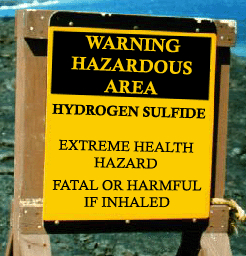Oil and Gas Well Drilling and Servicing eTool
General Safety and Health » H2S Safety and Health Hazards
H2S or sour gas is often found in oil and gas formations. It is a colorless gas that is highly toxic and extremely flammable. It is heavier than air and may travel along the ground or accumulate in low-lying areas. At low concentrations, it smells like "rotten eggs," but at higher concentrations it does not have a noticeable odor. At higher concentrations it can quickly – almost immediately – overcome unprotected workers, including rescue workers. This swift unconsciousness is often referred to as "knockdown."
Many wells where H2S gas is found have been identified, but pockets of the gas can occur anywhere and at any time. Sweet wells (containing no H2S) have been known to turn sour overnight. Also, hydrochloric acid treatments, when in contact with iron sulfide corrosion products, can react to create H2S gas in the well bore or in rig tanks. H2S hazards may include and/or be related to the following:
Exposure to H2S by Inhalation
Exposure by breathing (inhalation of) H2S is a primary concern. H2S fires and explosions occur at much higher concentrations than exposure limits (i.e., death can result from H2S inhalation exposures of 700-1000 ppm, while fire and explosion hazards are at levels above 40,000 ppm).
H2S accompanies the release of any oil or gas from a well system where H2S exists. Post warning signs indicating the hazards associated with the release of H2S at any well site that has H2S present in the system at high concentrations.
H2S gas causes a wide range of health effects depending on how much H2S is inhaled, and for how long. Exposure to high concentrations can quickly lead to incapacitation and death. The NIOSH IDLH (Immediately Dangerous to Life and Health) limit is only 100 parts per million (ppm). Refer also to OSHA’s Safety and Health Topic Page regarding H2S hazards.

The OSHA permissible exposure limit (PEL) to H2S for general industry is 20 ppm, which is not to be exceeded at any time during an 8-hour shift, except that an exposure of 50 ppm H2S is allowed for up to 10 minutes per 8-hour period as long as no other measurable exposure occurs during that 8-hour time period (see 29 CFR 1910.1000, Table Z-2). Health effects begin with prolonged exposures as low as 2 to 5 ppm – potentially resulting in nausea, tearing of the eyes, headaches, and loss of sleep. Generally, industry practice uses 10 ppm as an alarm set point to warn workers of the hazard, and to evacuate the area, and the NIOSH Recommended Exposure Limit is 10 ppm.
H2S sometimes can be detectable by its characteristic odor; however, the sense of smell cannot be relied upon to provide a warning of higher concentrations of the gas (i.e., greater than 100 ppm) because H2S rapidly eliminates the sense of smell (due to paralysis of the olfactory nerve). Longer exposures to lower concentrations also have a similar desensitizing effect on the sense of smell. Never rely on sense of smell for the presence of H2S.
The toxic hazards associated with H2S exposure are serious at well sites. Many fatalities have occurred. Maintain strict diligence to prevent and control exposure.
Possible Solutions
- Even in areas where H2S has not been seen, H2S still may suddenly present a situation where action is required. The presence of H2S should always be a concern. Establish and follow company policies, emergency procedures, and contingency plans for personnel if H2S is suspected or detected. Consult API standards and recommended practices, including API RP 49.
- Good planning and training programs for workers are the best ways to prevent exposure, injury, and death.
- Actively monitor for H2S gas, including both personal and area monitoring. Wear or place personal and area monitors in, or as close as possible to, the breathing zone.
- Provide comprehensive training for workers in H2S operations. Refer to ANSI/ASSE Z390.1-2017, Accepted Practice for H2S Safety Training Programs, when establishing the training program. Example topics include:<
- Identification of the characteristics, sources, and hazards of H2S.
- Proper use of the H2S detection methods used on the site.
- Recognition of, and proper response to, H2S warnings at the workplace.
- Symptoms of H2S exposure.
- Proper rescue techniques and first-aid procedures to be used in a H2S exposure.
- Proper use and maintenance of PPE, with demonstrated proficiency in using the PPE.
- Worker awareness and understanding of workplace practices and maintenance procedures to prevent exposure to H2S.
- Wind direction awareness (windsocks) and routes of egress.
- Confined space and enclosed facility entry and work procedures.
- Locations and use of safety equipment.
- Locations of safe briefing areas.
- Use and operation of all H2S monitoring systems.
- Wearing personal monitors as close as possible to the breathing zone to be most effective (e.g., above the chest or on the collar).
- Emergency response procedures, corrective actions, and shutdown procedures.
- Effects of H2S on the components of the H2S handling system (i.e., metal corrosion or fatigue).
- The importance of drilling fluid treatment plans prior to encountering H2S.
- Provide training before beginning work assignments.
- When concentrations of H2S are unknown in an area:
- Wear a NIOSH approved supplied-air respirator until H2S concentrations can be characterized.
- Use the buddy system for all initial characterizations.
- Before downgrading to other respiratory protection equipment, always acquire reliable quantitative data.
- Ensure that monitors are properly maintained and calibrated. Refer to manufacturer’s requirements.
- Develop and implement an H2S contingency plan (see API RP 49), including, but not limited to:
- Appropriate instruction in the use of H2S safety equipment to all personnel present at all H2S hazard areas.
- Gas detection monitoring and alarms where H2S may exist.
- Appropriate respiratory protection for normal and emergency use.
- Develop and implement an emergency response plan (see 29 CFR 1910.120(q) for more information).
- Ensure the use of air-supplied respirators, such as self-contained breathing apparatus, for emergency responders who will be entering areas of unknown concentrations of H2S.
It is possible for H2S gas to accumulate in any low area or in enclosed areas, such as gas venting systems, mud systems, cellars, pits, and tanks. A condition referred to as "knockdown," or swift unconsciousness, can occur in such locations, with collapse occurring with 1 to 2 breaths. Breathing then stops and death occurs within minutes if H2S exposure continues.
Simply opening a hatch can lead to knockdown if a worker breathes in gases coming out of the hatch. An H2S meter will not provide fast enough warning in this situation, as knockdown is almost immediate when H2S is at or above 700 ppm.
Possible Solutions
- Refer to the possible solutions in the Exposure to H2S by Inhalation section, above.
- Restrict/prevent access to areas that could contain H2S concentrations in the air.
- Provide adequate ventilation for the removal of any accumulations of H2S.
- Provide adequate respiratory protection and training to anyone who must enter an area that contains, or might contain, H2S.
- Implement an effective confined space entry program.
H2S is very flammable and will ignite at concentrations in the air between 4.0% and 46.0% H2S (Refer to the NIOSH Pocket Guide and to ANSI/ASSE Z390.1-2017).
A byproduct of combustion of H2S is toxic SO2 gas. SO2 gas will most likely be present when there has been a fire or explosion involving H2S. Wear proper PPE when responding to a fire or explosion incident, including proper respiratory protection. Not all H2S is burned off at the flare. Therefore, both H2S and SO2 emissions are possible, and are to be avoided, at flare discharges.
Possible Solutions
- See the Fire and Explosion section for possible solutions to fire and explosion hazards.
- Consider these hazards during RAs/HAs/JSAs and make responders to fires or explosions involving H2S aware of the H2S and SO2 exposure hazards.
- Provide H2S and SO2 training to responders before response.
- Use SO2 monitors if exposure to SO2 is possible, or if responding to an H2S fire or explosion.

H2S is highly corrosive and causes metals to thin or to become brittle. Therefore, employers need to take special precautions when choosing equipment when they may reasonably expect to encounter H2S. National Association of Corrosion Engineers (NACE) standard MR 0175 includes recommendations for selection of specific materials when H2S is present. See also the Additional Information for H2S section below.
Metal fatigue, including hydrogen embrittlement, or sulfide stress cracking, can result in equipment failure, which can release H2S gas, and lead to H2S exposure and injury.
Possible Solutions
- Select materials in H2S service in accordance with NACE specifications, standards, and recommended practices.
- Inspect equipment and materials according to API standards and recommended practices, and to manufacturers' recommendations, to identify and remove from service anything damaged by H2S corrosion before failures occur.
- Pay attention to older equipment that has been in H2S service.
- Do not step on, or hammer on, piping susceptible to H2S corrosion. Brittleness is possible, and a gas release could occur.
- Inspect metal ladders, steps, and stairways for corrosion. The metal, and/or the bolts, could be corroded enough to result in collapse when a load is applied (i.e., either personnel or equipment loads).
- Perform non-destructive testing periodically on piping and vessels in accordance with API standards.
- Treat drilling fluids with corrosion inhibitors, pH adjusters, or other products to chemically reduce corrosion failures.
- Standards. API.
- Search for Standards. ANSI.
- International Association of Drilling Contractors (IADC). Health, Safety & Environmental (HSE) Reference Guide.
- ANSI/ASSE Z390.1 - 2017, Accepted Practices for H2S Safety Training Programs.
- H2S. NIOSH Safety and Health Topic.
- MR 0175C, Metals for Sulfide Stress Cracking and Stress Corrosion Cracking Resistance in Sour Oilfield Environments. NACE, (December 2003) [Also International Standards Organization (ISO) 15156, Petroleum and natural gas industries-Materials for use in H2S containing environments in oil and gas production.]

